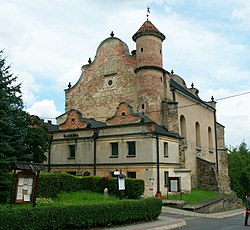Lesko
Lesko | |
|---|---|
 | |
| Country | |
| Voivodeship | Subcarpathian |
| County | Lesko County |
| Gmina | Gmina Lesko |
| Established | 14th century |
| Town rights | before 1470 |
| Government | |
| • Mayor | Barbara Jankiewicz |
| Area | |
| • Total | 15.09 km2 (5.83 sq mi) |
| Population (2006) | |
| • Total | 5,864 |
| • Density | 390/km2 (1,000/sq mi) |
| Time zone | UTC+1 (CET) |
| • Summer (DST) | UTC+2 (CEST) |
| Postal code | 38-600 |
| Area code | +48 13 |
| Car plates | RLS |
| Website | http://www.lesko.pl |
Lesko [Polish pronunciation: ['] ] (or Lisko until 1926) ([לינסק-Linsk] Error: {{Lang-xx}}: text has italic markup (help)) is a town in south-eastern Poland with a population of 5,855 (2004), in the Bieszczady mountains. It is located in the heartland of the Doły (Pits), and its average altitude is 390 metres above sea level, although there are some hills located within the confines of the city. Since 2002 it has been the capital of Lesko County.
Lesko is situated in the Subcarpathian Voivodeship (since 1999); previously it was in Krosno Voivodeship (1975-1998).
History
Lesko was probably founded in the fourteenth century; records first mention it in 1436. It was granted its town charter in approximately 1469, when it was owned by the Kmita family. In the seventeenth century, the town was quite an important centre of trade and craftsmanship, with approximately 1,500 inhabitants. Its heyday ended in 1704, when it was looted by the Swedish troops during the Great Northern War.
Currently Lesko is a gateway to the Bieszczady Mountains. The city has numerous outdoor recreational clubs.
Sites of interest
- Gothic church built in 1539 by the Kmit family. Destroyed by a Swedish attack, the church was reconstructed. A Baroque interior has survived, featuring an altar blessed by Pope John Paul II.
- Castle of the Kmita family, built in the sixteenth century, then reconstructed, partially destroyed and rebuilt. At one time, it was the home of the Polish poet Wincenty Pol. It now houses many works of notable European painters and writers.
- former synagogue, built during the sixteenth and seventeenth centuries, then reconstructed. Destroyed during the Second World War, then rebuilt. It currently houses an art gallery.
- Kirkut (Jewish cemetery), with graves dating back to the sixteenth century. One of Poland's oldest Jewish cemeteries, it contains over 2,000 headstones.
- Town Hall building, which dates back to 1896.
- Lesko Stone, a popular geological formation.

People
- Franciszek Ksawery Abancourt - writer, scientist
- Janusz Gołda - novelist, publicist
- Korneliusz Pacuda - musician, Honorary Citizen
Hiking trails

Literature
- Prof. Adam Fastnacht. Slownik Historyczno-Geograficzny Ziemi Sanockiej w Średniowieczu (Historic-Geographic Dictionary of the Sanok District in the Middle Ages), Kraków, 2002, ISBN 83-88385-14-3.
